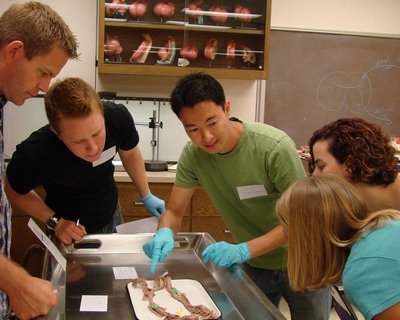February 14, 2008
Neurobiology & Behavior students reach out
& George Martinez
Graduate School
Hirofumi Watari, known as Hiro, noted that it was his fellow graduate student Jonathan Ting, now a post-doc at Duke, who saw the potential of forming an outreach organization of graduate students in the Neurobiology & Behavior Program, one of 13 interdisciplinary programs administered by the Graduate School.
“There were about 10 of us who had been working as individual volunteers on outreach efforts, especially with Dr. Eric Chudler’s Brain Awareness events. But one day Jonathan said to us: ‘We could do so much more if we formed our own organization and encouraged the other graduate students to work with us.’ ”
Ting wrote a proposal in 2006 for UW President Mark Emmert’s Learning for Leadership initiative, and with this support, the group was able to begin developing new teaching materials and do some serious volunteer recruitment. From the three founders, who included Bryan White, a former high school teacher now working on his Ph.D., as well as Ting and Watari, the group quickly expanded to about 20.
By the fall of 2007, Neurobiology & Behavior Community Outreach, now a registered student organization, won the first annual Next Generation Award from the Society for Neuroscience, a leading organization in the field with almost 38,000 members. The award honors “outstanding contributions to public outreach and science education.”
The Society for Neuroscience was also behind one of the motivations for the graduate student group, Watari noted, because about the same time the student group organized, the society called on its members to make a commitment to public outreach in order to increase public support for neuroscience research.
Another motivation was the students’ sense that the Neurobiology & Behavior Program, which has about 70 graduate students ranging from their first to their sixth years, could have more sense of community and shared activities.
But the primary motivator, he said, is really just the students’ enthusiasm about sharing what they’ve learned and building more support for basic science research.
White, the other organizer still at the UW, said that most graduate students enjoy a chance to share their passion for science with younger students. “Explaining neuroscience phenomena and seeing the excitement of students gives us a broader perspective on our own research,” he said.
Along with visits to classrooms, the group organizes and staffs events such as the upcoming Brain Awareness Week exhibits planned at the UW HUB’s West Ballroom from 10:30 a.m. to 1:30 p.m. on March 3. That event will draw about 600 invited first- to 12th-grade students and have at least 40 different learning stations. Members of the UW community are also welcome to attend.
Another recent effort was participation in the Pacific Science Center’s Life Sciences presentations. The Neurobiology & Behavior group had volunteers there for four days, answering questions and working with the public.
Some members of the group have focused on developing Web-based lesson plans for elementary and high school teachers, Web-based videos and other multimedia that anyone can use to learn and explore neuroscience.
A somewhat more subtle and long-term goal of the group is changing the culture of basic sciences research to embrace outreach and increase communication with the public. White has been particularly interested in seeing the next generation of neuroscientists learn how to make their work more accessible.
By now, several graduate students from other programs have joined the group and their list of planned activities keeps growing. As the group has developed, sustainability has become a focus.
“I’m in my fifth year now, and Bryan is in his sixth year,” Watari said. “So we’ve been thinking about how we can pass this along and develop a set of materials and plans that others will be able to use down the road. The Web site is good for making things accessible, and we also think it’s a good way to give these things a place to be passed along.”
Chudler, director of education and outreach in the Department of Bioengineering, whose Brain Awareness events first brought the founding members together, said, “The students’ work establishing Neurobiology & Behavior Community Outreach has created the foundation for neuroscience community interaction within the Puget Sound area that will last for years.”
The group’s Web site: http://students.washington.edu/watari/about/nboutreach.html.
Chudler’s “Neuroscience for Kids” site: http://faculty.washington.edu/chudler/neurok.html.
Brain Awareness Week exhibits will be on display from 10:30 a.m. to 1:30 p.m. Monday, March 3, in the HUB’s West Ballroom.



